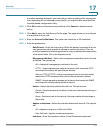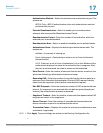
Security
Defining Storm Control
261 Cisco Small Business 200 Series Smart Switch Administration Guide
17
• Type—IP protocol the service uses.
• Local IP Address—Local IP address through which the device is offering
the service.
• Local Port—Local UDP port through which the device is offering the service.
• Application Instance—The service instance of the UDP service. (For
example, when two senders send data to the same destination.)
STEP 3 Click Apply. The services are written to the Running Configuration file.
Defining Storm Control
When Broadcast, Multicast, or Unknown Unicast frames are received, they are
duplicated, and a copy is sent to all possible egress ports. This means that in
practice they are sent to all ports belonging to the relevant VLAN. In this way, one
ingress frame is turned into many, creating the potential for a traffic storm.
Storm protection enables you to limit the number of frames entering the device
and to define the types of frames that are counted towards this limit.
When the rate of Broadcast, Multicast, or Unknown Unicast frames is higher than
the user-defined threshold, frames received beyond the threshold are discarded.
To define Storm Control:
STEP 1 Click Security > Storm Control.
All the fields on this page are described in the Edit Storm Control page except for
the Storm Control Rate Threshold (%). It displays the percent of the total
available bandwidth for unknown Unicast, Multicast, and Broadcast packets
before storm control is applied at the port. The default value is 10% of the
maximum rate of the port and is set in the Edit Storm Control page.
STEP 2 Select a port and click Edit.
STEP 3 Enter the parameters.
• Interface—Select the port for which storm control is enabled.
• Storm Control—Select to enable Storm Control.


















